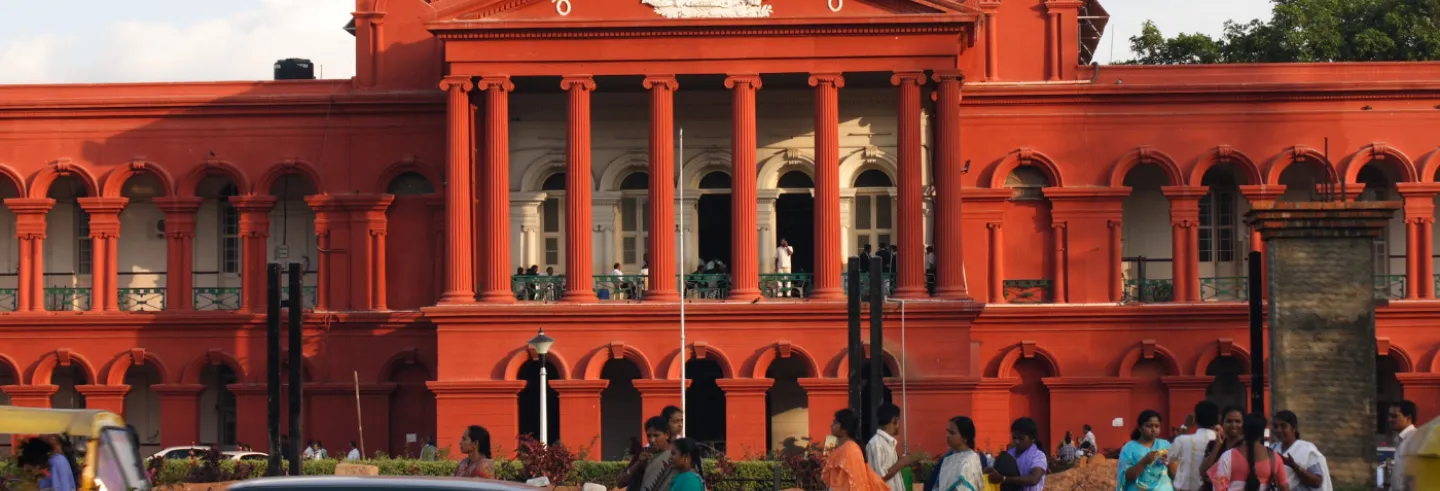The Karnataka state legislature approved the Karnataka Conduct of Government Litigation Act, 2023 (the Act) in July 2023. The Act seeks to consolidate the earlier rules, circulars, notifications, and orders relating to the conduct of government litigation before courts and tribunals. Government litigation includes cases filed by or against a wide range of state actors—government departments, authorities and agencies, statutory undertakings, government corporations, public educational institutions, and their designated officers.
The Act provides guidelines and process maps for the Karnataka state government to streamline its litigation in civil and criminal matters, writ petitions and appeals, and in matters before the Supreme Court of India. The law laments that the lack of an effective dispute resolution mechanism has resulted in the state government losing several important cases in the past. It therefore intends to ensure that the government is made accountable and that it acts in an efficient and responsible manner in the conduct of its litigation.
States are usually the biggest litigants. Countries have used dispute resolution policies containing strategies for helping the state manage its disputes and reduce the case backlog before courts. High volumes of government litigation raise several issues—wasteful expenditure of public resources, erosion of people’s trust in state institutions, and the real-world financial implications of missed contracts, failed deadlines, and incomplete projects.
In India, the need to manage government litigation has been part of policy discussions from the 1970s.
There is tacit recognition that the state is a different type of litigant from its citizens, a “repeat player” with systemic advantages such as access to high-quality legal advice and other resources. In an adversarial setting, this has a disproportionate impact on the opposite party’s ability to get a successful outcome. The government has deep pockets and several resources at its disposal to defend cases. Despite this, it appears to be indifferent to the high volume and costs of its own litigation, and, by default, opts to fight cases.
In India, the need to manage government litigation has been part of policy discussions from the 1970s. After several committee reports and directives from the Supreme Court, the department of legal affairs framed a national litigation policy in 2010 with the intention of making the union government a “responsible and efficient litigator”. Following this, several states approved their own litigation/dispute resolution policies with the same objective. Some states such as Maharashtra, Rajasthan and Madhya Pradesh followed this up with specific rules/departmental manuals to manage the conduct of government litigation, while some others did not even provide for such a policy.
Broadly, state policies on litigation are expected to manage the existing litigation risk in a cohesive, coordinated, and time-bound manner, and reduce the state’s litigation burden (and hence, wasteful expenditure). They aim to make the state a model litigant by introducing innovative strategies and streamlined processes in government bodies so as to bring “a visible and enduring qualitative and quantitative improvement in the manner in which litigation is perceived”. The bigger goal is to reduce judicial pendency and “protect the rights of the citizens and secure social justice for the welfare of people”.
In Karnataka, a new dispute resolution policy called the Karnataka State Dispute Resolution Policy came into effect in 2021, superseding the litigation policy of 2011. The 2011 policy had not been implemented in government departments and government lawyers were not even aware of its existence. So, the 2021 policy aimed to improve the status of government litigation and instil principles such as responsibility, accountability, and efficiency in the state’s approach to the management of disputes, beyond courts and also by using alternative dispute resolution mechanisms.
It covered all disputes involving government departments and the inter-departmental disputes pending before courts or tribunals, or arbitration bodies, as well as disputes before lok adalats and quasi-judicial authorities, whether as the petitioner/appellant or the defendant. The 2021 policy was pragmatic in its incorporation of technology to design a SMART—specific, measurable, assignable, realistic, and time-bound—system.
Officers conducting litigation were unaware of the existence of the 2021 policy and lacked the training to overhaul the existing processes for litigation management as set out under the Karnataka Conduct of Government Litigation Rules, 1985.
So, what prompted the Karnataka state legislature to pass the new Act in absolute haste, with minimal discussion and no public feedback?
In a study conducted by the National Law School of India University to empirically evaluate the working of the 2021 policy, which the authors participated in, it was noted that the policy was purely recommendatory and not binding on the state. It was therefore not able to achieve the objective of effectively managing the state government’s litigation. The 2021 policy had several strong safeguards built into it (such as multiple levels of monitoring of disputes) and it also had detailed protocols for managing cases and building a strong technological support system. Yet, it failed in its operation.
Officers conducting litigation were unaware of the existence of the 2021 policy and lacked the training to overhaul the existing processes for litigation management as set out under the Karnataka Conduct of Government Litigation Rules, 1985. Everyday processes at government departments were routinely conducted without a structured workflow, instead relying on internal protocols and departmental hierarchies.
The National Law School study made several recommendations on aspects of dispute resolution not addressed by the 2021 policy.
• Need for providing a publicly accessible list of government advocates and regularly updating this list.
• Need for transparency in appointments of government lawyers.
• Need for an empowered committee to be set up expeditiously, which is to have access to the complete category-wise and district-wise database of pending government cases to help the committee assess stakeholder actions more effectively.
• Setting up the Karnataka Government Dispute Management Information Technology Cell on a priority basis.
• Setting up government department-level dispute resolution boards on a priority basis and widely circulating information about them to all government departments.
• Need for a single web-based case monitoring system, which integrates all case information of the state departments; similar to the Legal Information Management and Briefing System (LIMBS) to maintain and regularly update government litigation-related data.
• Need for digitisation of litigation records on a priority basis.
• Need for each government department/authority/board to develop specific standard operating procedure(s)/protocol(s) to ensure uniform and standard processes in the management of cases.
• Need for court-department liaison and process-oriented reforms (for instance, risk analysis of outcomes and impact of disputes, ensuring efficient workflow management and devising effective dispute resolution strategies) to be implemented by stakeholders.
The Act, which borrows concepts from the 2021 policy such as “nodal officer” and “incorporation of technology”, leaves these important issues unaddressed. This means the drawbacks of the 2021 policy remain. The 2021 policy imposed greater accountability on government officers and counsels for effective conduct of government disputes through a two-fold evaluation mechanism—external, through empowered committees specifically set up for this purpose, and internal, through constant self-assessment by stakeholders within government bodies. The Act acknowledges this by introducing specific committees at the state and district levels—however, without much thought as to whether a new law was necessary for this.
In any case, these changes have little effect because they are yet to be notified. The substance of the law, such as the procedure specified for conduct of government litigation, remains the same as in the 1985 rules. Like it, the Act has separate sections with detailed procedures for handling litigation in the Supreme Court, and for land acquisition, motor accident claims, execution matters, and criminal law cases.
The Act streamlines procedures under separate headings for easier reading. For instance, the responsibilities of various officers—law officers, prosecutors, government pleaders, litigation conducting officers, law secretary and other departmental secretaries—are clearly demarcated in the Act. This is in contrast to the 1985 rules where the roles and responsibilities were lumped together, making them difficult to follow. Some minor changes made to the procedure—for instance, the responsibility for examining the feasibility of filing an appeal or special leave petition before the Supreme Court on a government litigation vests with the Law Secretary and not, as in the 1985 rules, with the Legal Cell—are not very significant.
A salient feature of the 2021 policy was its emphasis on technological interventions beyond mere digitisation. The idea was that such technological infrastructure was bound to support data and workflow management and lead to tangible technology-based solutions to manage and mitigate disputes. Realising the value of systematic collection, cataloguing, and management of government litigation data, the 2021 policy discussed creation of the architecture of a data management system by evolving suitable strategies, practices, and protocols.
The Act emphasises the need to “safeguard government interest” in all matters. Law officers are required to file suits and appeals against court decisions that adversely affect the government’s interests while simultaneously defending them in court.
Now, the Act merely requires government departments, authorities and bodies to utilise one tool—the court case monitoring system, or CCMS—to track, follow up, and ensure timely action on cases. Importantly, it fails to harness the huge potential of other technological tools and a holistic tech framework for better interactions between the government and citizens to enhance citizen participation in the public sphere.
The Act, like the 1985 rules, emphasises the need to “safeguard government interest” in all matters. Law officers are required to file suits and appeals against court decisions that adversely affect the government’s interests while simultaneously defending them in court. This is significant since our study data clearly demonstrates that the state government defends more cases than it initiates, and so the focus should be on more disposals and reducing appeals.
In writ petitions (involving fundamental rights), the new law requires the departmental secretary to consider whether the government can provide interim relief to a petitioner without the need to appear before court. While this should, in theory, reduce litigation, it rarely happens in practice, the default state practice being to litigate. The Act imposes no penalties on officers for delay in conduct of litigation, or for their failure to use settlement or alternative means to resolve disputes at the level of the government itself. Interestingly, despite the stated object being to reduce matter pendency, the Act does not encourage any alternative modes of dispute resolution.
Karnataka has embarked on a mission to use a statute for effective management of “unwanted and avoidable” government litigation, rather than simplified guidelines. While legislation is a powerful instrument to set standards of conduct, it may not be the best means for changing the government’s compulsive litigating culture, which is deeply ingrained.
There is lack of training for, or even knowledge of, methods for effectively conducting government litigation. Any change to this is a slow, iterative process, which requires strong leadership, detailed planning to align the interests of several stakeholders, and an unwavering commitment from government functionaries to internalise the spirit of this law to produce better results.










